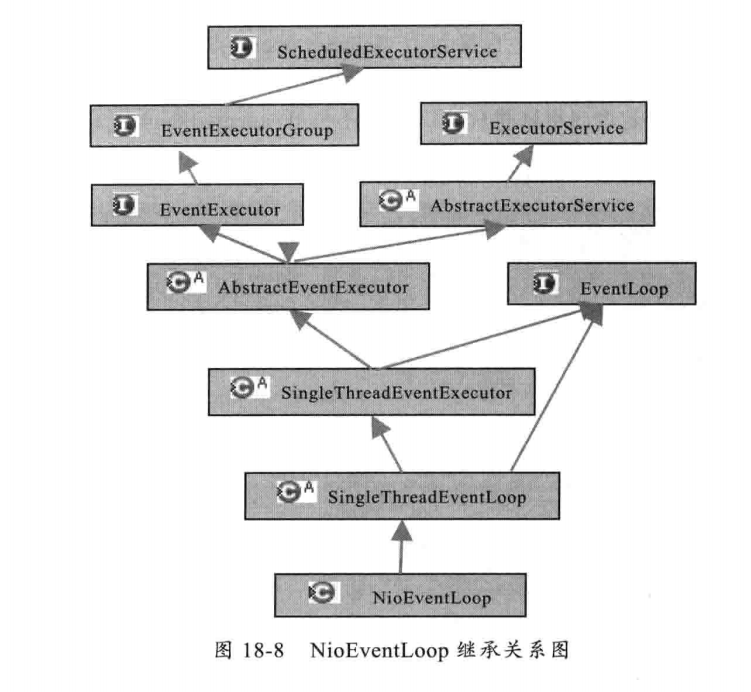上一篇博客【Netty源码学习】EventLoopGroup中我们介绍了EventLoopGroup,实际说来EventLoopGroup是EventLoop的一个集合,EventLoop是一个单线程的线程池,其接口和类实现关系如下:
接下来我们主要介绍实现类NioEventLoop中实现的操作,通过NioEventLoop的继承关系图我们可以看到,其就是一个单线程的线程池。
首先我们看NioEventLoop的构造函数
在构造函数中我们可以看到,其主要操作有获得NIO操作的Selector, selector = openSelector();
NioEventLoop(NioEventLoopGroup parent, Executor executor, SelectorProvider selectorProvider,
SelectStrategy strategy, RejectedExecutionHandler rejectedExecutionHandler) {
super(parent, executor, false, DEFAULT_MAX_PENDING_TASKS, rejectedExecutionHandler);
if (selectorProvider == null) {
throw new NullPointerException("selectorProvider");
}
if (strategy == null) {
throw new NullPointerException("selectStrategy");
}
provider = selectorProvider;
selector = openSelector();
selectStrategy = strategy;
}selector = openSelector();具体的操作其实就是获取一个Selector
private Selector openSelector() {
final Selector selector;
try {
selector = provider.openSelector();
} catch (IOException e) {
throw new ChannelException("failed to open a new selector", e);
}
if (DISABLE_KEYSET_OPTIMIZATION) {
return selector;
}
final SelectedSelectionKeySet selectedKeySet = new SelectedSelectionKeySet();
Object maybeSelectorImplClass = AccessController.doPrivileged(new PrivilegedAction<Object>() {
@Override
public Object run() {
try {
return Class.forName(
"sun.nio.ch.SelectorImpl",
false,
PlatformDependent.getSystemClassLoader());
} catch (ClassNotFoundException e) {
return e;
} catch (SecurityException e) {
return e;
}
}
});
if (!(maybeSelectorImplClass instanceof Class) ||
// ensure the current selector implementation is what we can instrument.
!((Class<?>) maybeSelectorImplClass).isAssignableFrom(selector.getClass())) {
if (maybeSelectorImplClass instanceof Exception) {
Exception e = (Exception) maybeSelectorImplClass;
logger.trace("failed to instrument a special java.util.Set into: {}", selector, e);
}
return selector;
}
final Class<?> selectorImplClass = (Class<?>) maybeSelectorImplClass;
Object maybeException = AccessController.doPrivileged(new PrivilegedAction<Object>() {
@Override
public Object run() {
try {
Field selectedKeysField = selectorImplClass.getDeclaredField("selectedKeys");
Field publicSelectedKeysField = selectorImplClass.getDeclaredField("publicSelectedKeys");
selectedKeysField.setAccessible(true);
publicSelectedKeysField.setAccessible(true);
selectedKeysField.set(selector, selectedKeySet);
publicSelectedKeysField.set(selector, selectedKeySet);
return null;
} catch (NoSuchFieldException e) {
return e;
} catch (IllegalAccessException e) {
return e;
}
}
});
if (maybeException instanceof Exception) {
selectedKeys = null;
Exception e = (Exception) maybeException;
logger.trace("failed to instrument a special java.util.Set into: {}", selector, e);
} else {
selectedKeys = selectedKeySet;
logger.trace("instrumented a special java.util.Set into: {}", selector);
}
return selector;
} public void register(final SelectableChannel ch, final int interestOps, final NioTask<?> task) {
if (ch == null) {
throw new NullPointerException("ch");
}
if (interestOps == 0) {
throw new IllegalArgumentException("interestOps must be non-zero.");
}
if ((interestOps & ~ch.validOps()) != 0) {
throw new IllegalArgumentException(
"invalid interestOps: " + interestOps + "(validOps: " + ch.validOps() + ')');
}
if (task == null) {
throw new NullPointerException("task");
}
if (isShutdown()) {
throw new IllegalStateException("event loop shut down");
}
try {
ch.register(selector, interestOps, task);
} catch (Exception e) {
throw new EventLoopException("failed to register a channel", e);
}
}父类重写了线程池操作的类
@Override
public void execute(Runnable task) {
if (task == null) {
throw new NullPointerException("task");
}
boolean inEventLoop = inEventLoop();
if (inEventLoop) {
addTask(task);
} else {
startThread();
addTask(task);
if (isShutdown() && removeTask(task)) {
reject();
}
}
if (!addTaskWakesUp && wakesUpForTask(task)) {
wakeup(inEventLoop);
}
}在NioEventLoop中的run方法中我们可以看到任务队列的执行
@Override
protected void run() {
for (;;) {
try {
switch (selectStrategy.calculateStrategy(selectNowSupplier, hasTasks())) {
case SelectStrategy.CONTINUE:
continue;
case SelectStrategy.SELECT:
select(wakenUp.getAndSet(false));
if (wakenUp.get()) {
selector.wakeup();
}
default:
// fallthrough
}
cancelledKeys = 0;
needsToSelectAgain = false;
final int ioRatio = this.ioRatio;
if (ioRatio == 100) {
processSelectedKeys();
runAllTasks();
} else {
final long ioStartTime = System.nanoTime();
processSelectedKeys();
final long ioTime = System.nanoTime() - ioStartTime;
runAllTasks(ioTime * (100 - ioRatio) / ioRatio);
}
if (isShuttingDown()) {
closeAll();
if (confirmShutdown()) {
break;
}
}
} catch (Throwable t) {
logger.warn("Unexpected exception in the selector loop.", t);
// Prevent possible consecutive immediate failures that lead to
// excessive CPU consumption.
try {
Thread.sleep(1000);
} catch (InterruptedException e) {
// Ignore.
}
}
}
}





















 344
344











 被折叠的 条评论
为什么被折叠?
被折叠的 条评论
为什么被折叠?








